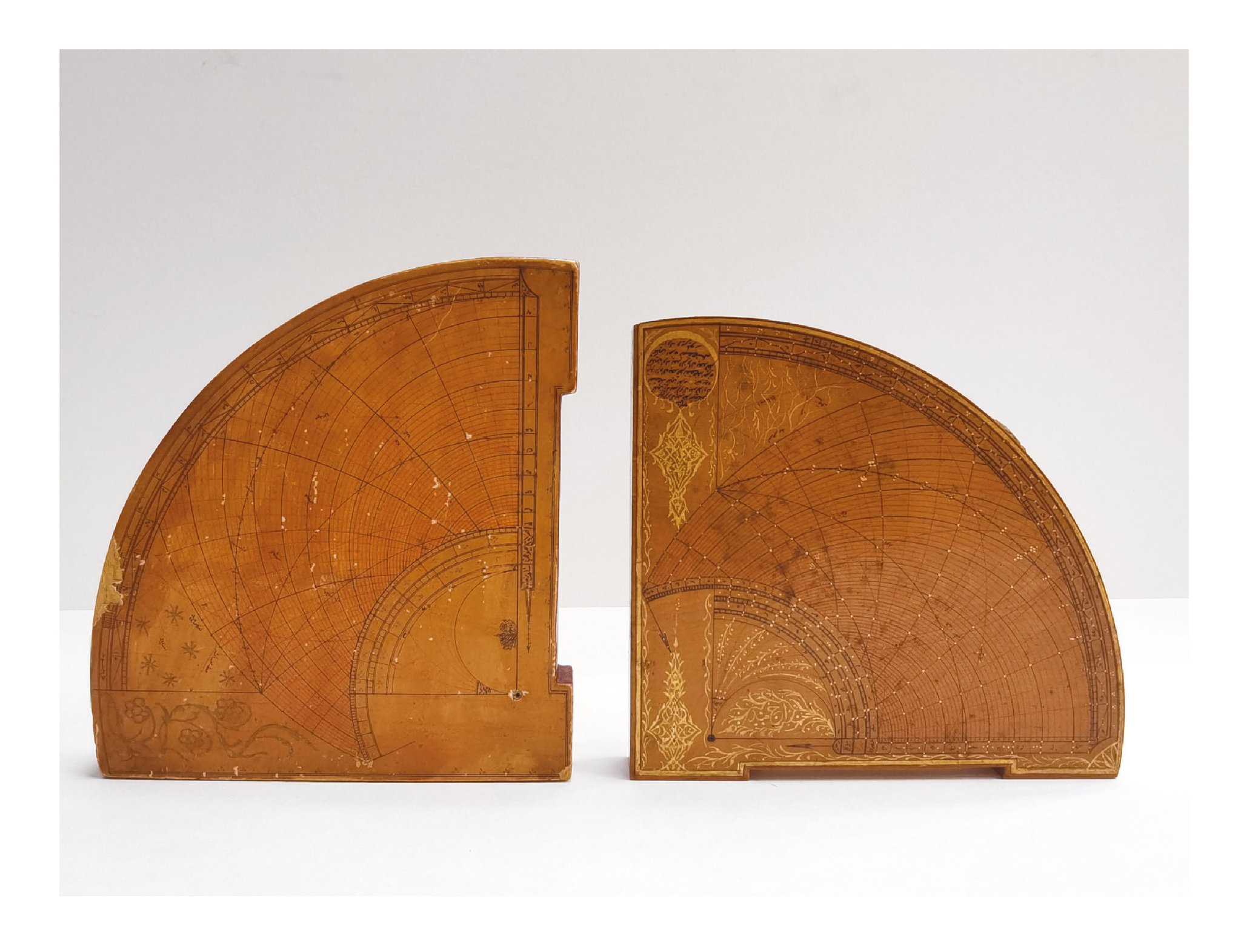
MUVAKKITHANE
Author: Hamza Lavić, MA, Gazi Husrev-bey Library • Illustration: Rub‘ tahte Instruments for determining the prayer time, usually made of wood, silver, brass and ivory

In the context of measuring time and its practical use in Muslims' daily life, two kinds of buildings have marked spaces where the Ottoman Empire used to spread – muvakkithanes and clock-towers.
Muvakkithanes are facilities which house astronomer's items for measuring times of beginnings of daily prayers and producing calendars, which were built as parts of the complex of individual waqfs, typically next to the mosque. People who worked in muvakkithanes were specialized astronomers, which are called muwaqqits. The muwaqqit is the first institutionalized astronomer profession in Bosnia and Herzegovina. His task is to produce taqwim, i.e. calendar, to determine the beginning of the five daily prayers and to take care of instruments which are used in the muvakkithane.
Since clock-towers were usually situated near muvakkithanes, muwaqqit's job description often included regulation of functioning of the mechanism of the clock in the clock-tower, in line with lunar calendar.
Upon entering the Oriental-Islamic religious and cultural-civilizational circle through Ottomans in the mid-15th century, Muslims of Bosnia and Herzegovina faced practical challenges related to determining the accurate timeframe of performing daily prayers. For a long time, Muslims determined the beginning of daily prayers and the appearance of the new moon using the so-called “folk astronomy”, which consisted of optical seeing the new moon in the sky, or tracing the size of the shadow of some objects. Since individual astronomers did not agree in their estimates, believers were confused and the Ottoman administration began to establish official institutions. Muvakkithanes were founded by waqfs or sultan's governors, and muwaqqits were typically employees of individual waqfs who received monthly remuneration for their work. It was during the rule of sultan Mehmed II Fatih that the first muvakkithane was built in the Ottoman Empire as part of his waqf complex in Istanbul, and other ones followed in other parts of the Empire.
The oldest record of a muvakkithane in Bosnia and Herzegovina in the available literature is found in the waqfnama (deed of endowment) of Ćejvan-ćehaja in Mostar, drawn up in 1558, where the list of waqf inventory includes two kinds of clock mechanisms: “čan-sahatˮ – a clock with the bell, and“kum-sahat“ – the hourglass. Still, the first official muvakkithane in Bosnia and Herzegovina was commissioned by Bosnian vali Huršid-pasha next to the Emperor Mosque in Sarajevo in 1853/54, who also defined the waqf which would fund this institution. In the years that followed, muvakkithanes were built in Banja Luka, Mostar, Gradačac and Tuzla. It is known that, in the past, a total of nineteen clock-towers were built in BiH besides muvakkithanes: there were two in Travnik and Sarajevo each, while there was one in Banja Luka, Donji Vakuf, Foča, Gornji Vakuf, Gračanica, Gradačac, Livno, Jajce, Maglaj, Mostar, Nevesinje, Počitelj, Prozor, Prusac, Stolac, Tešanj and Trebinje, respectively. The clock-tower next to the Gazi Husrev-bey Mosque still uses „a la turka“, i.e. the lunar way of measuring time.
The first official muwaqqit in our country was Ali Šerif Faginović, a well-known calligrapher who performed this job in the muvakkithane next to the Emperor Mosque from 1854 to 1921. One of the best-known muwaqqits in Bosnia and Herzegovina was also Salih Sidki Hadžihusejnović, the first muwaqqit of Gazi Husrev-bey's waqf, who wrote several works about astronomy, and who is also well-known to public at large by the work Tarih-i Muvekkit, i.e. Muvekkitova istorija Bosne (A Muwaqqit's History of Bosnia).
The most significant instruments which were initially used in muvakkithanes were sundial, astrolabe, rub'-tahta or quadrant, gnomon, compass and spirit-level. Many samples of rub'tahtas have been preserved in muvakkithanes, museums and private collections in BiH, and based on signatures we know that they were also made by masters from Bosnia and Herzegovina such as Sidki Bosnevi, Mula Ibrahim, Jevrej Mirkado and Emin, son of Omer, in the 18th century, and Muhammed Akif Bosnevi, Ali, Ahmed Nijazi, Zuhdi Bosnevi and Mustafa in the 19th century, among others.
The best-known preserved sample of the sundial in Bosnia and Herzegovina is found on the right edge of the southwest part of the wall of the Hadži Ali-bey Mosque in Travnik. It is 2.4 meter high and is set according to accurately defined parameters of the site it is situated at. It was previously used to tune mechanical clocks built into two clock-towers in Travnik. In the muvakkithane of Gazi Husrev-bey's waqf in Sarajevo, one example of the watch of the same kind has been preserved.

